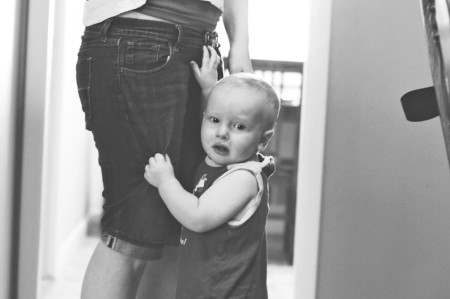I recently attended a foster parent training about how to help kids who have experienced trauma. (Spoiler alert– EVERY kid in foster care has experienced trauma because just the act of coming into foster care IS trauma). My favorite piece of wisdom from the night was a graphic about dealing with kids who are upset. The graphic said simply:
Anxious Child + Calm Adult = Calm Child
Now, anyone who has raised kids who have trauma in their background knows it isn’t always that simple. Sometimes you can be calm nearly to the point of comatose and an anxious child will continue to rage. I am a pretty calm person by nature and even in my most measured and quiet moments I have had kids scream, punch the wall, and throw their psych meds at me. Sadly, there is no perfect formula for controlling the behavior or emotional responses of the kids we love, but I do think this formula is an excellent one to keep in mind.
The importance of a calm, nurturing adult is something I’ve been mulling over for a few years, ever since I ran across this study of rat behaviors:
“Some mother rats spend a lot of time licking, grooming, and nursing their pups. Others seem to ignore their pups. Highly nurtured rat pups tend to grow up to be calm adults, while rat pups who receive little nurturing tend to grow up to be anxious.
It turns out that the difference between a calm and an anxious rat is not genetic—it’s epigenetic. The nurturing behavior of a mother rat during the first week of life shapes her pups’ epigenomes. And the epigenetic pattern that mom establishes tends to stay put, even after the pups become adults.”
I want to raise calm kids who become calm adults. If I choose to get angry and yell when they aren’t doing what I want them to do or behaving how I expect them to behave, I’m undermining my goal of raising calm (i.e. not anxious) adults. When my kids are stressed, if I respond by saying, “What is the matter with you? You’re being RIDICULOUS!” I am taking an anxious child, adding an anxious adult and then hoping we get a calm kid. That’s just not going to happen.
I learned this lesson for myself years ago when we were doing group home work. We had a student who was pretty constantly anxious. And his anxiety was contagious. When he was upset about something he would get loud, which would put other kids on edge since some of them had grown up in homes where loud voices had been a precursor to violence. When he got loud, it would be easy to find yourself trying to combat his anxious loudness with your own loud, firm voice. Even if you weren’t angry when you started that conversation, you could easily find yourself becoming agitated and what started as a simple request to have him do something he didn’t want to do would end up in shouting and door slamming.
One day I just got tired of it.
He and I had been making relational progress and I didn’t want to ruin that with one of these episodes. He got upset and instead of engaging in a battle of wills in the moment, I just asked him to go sit in the other room for a minute while I wrapped up what I was doing with another kid so we could talk, just the two of us. This gave us both a minute to calm down and helped ensure there weren’t other kids around who would be upset if he got worked up again. When I went over to him, I sat on the floor in front of him while he sat on a chair. I said as quietly as I could, “When you talk that way to me, it sounds like you’re really angry. I know you aren’t really angry right now and I know you love me, just like I love you. Can you tell me what’s wrong?” And then I watched this big teenaged boy break. He sat there and cried and we talked about how frustrated he gets and how he doesn’t want to lose his temper that way. I knew there had been a breakthrough in our relationship because I was able to be calm with him, to tell him I loved him and knew he loved me, and I set aside time to listen to his problem.
Did this solve all his issues? Not by a long shot. But it was the beginning of a positive relationship between the two of us and I love him to this day, problems and all. If the rat study is any indication, some of those patterns and struggles for him may have been set from his earlier years of having a mom who responded unpredictably because of her own struggles with substance abuse. It is difficult to undo those patterns, but when it comes to these precious kids, we’ve got to try.
This is why I’m not a yeller. When my kids are yelling, I tell them they need to start over but in a softer voice. When they yell, I whisper. When they are far away from me, I walk to them instead of screaming across the house or the neighborhood– just the act of yelling can be agitating for all of us. If for some reason I need to be loud to call them, I try to be singsongy (there’s a difference between yelling, “IT’S TIME FOR DINNER!” and singing loudly, “It’s time for DIIIIIIIINNNNNEEEEERRRRRR!”). When we need to have a serious conversation, I want to be sitting close to them, giving them physical contact and eye contact.
When my kids come to me for comfort, I pat their heads and stroke their cheeks and gently squeeze their shoulders. These are my “rat grooming behaviors” and sometimes when I’m tempted to say, “What is wrong with you?” I remind myself about how important it is for me to reassure my anxious child instead of adding to their anxiety. When they seem out of control, I give myself a quick pep talk: If I can be calm and controlled, I might be able to help them regain some control of themselves. If I respond with my own out of control behavior (yelling, stomping, huffing, eye rolling, slamming things around), it isn’t reasonable to expect them to behave any differently. That might mean I need to take a moment to get control of myself before interacting with them about their issue.
Next time you’re dealing with a child who is struggling with some strong emotions, just remember:
Anxious Child + Calm Adult = Calm Child
And then practice your best rat grooming behaviors. Maybe that will be the change you need to lower the stress level in your house and in your life.


3 Comments
Leave a reply →